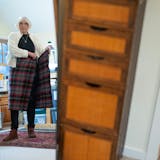Jeanette Root's grandmothers were young farm wives in 1920, when women won the right to vote. The two Minnesota women, lifelong friends, had a lot in common, but not when it came to casting ballots.
"Grandma Kate never missed her chance to vote. Grandma Nettie only voted when my grandpa told her who to vote for," said Root, 87. "I was named for Grandma Nettie, but I got Grandma Kate's genes when it comes to voting. I consider it my duty."
Now Root has immortalized her grandmothers in a quilt that includes their silhouettes.
It's one of 36 quilts hanging in the Lawshe Memorial Museum, operated by the Dakota County Historical Society. On display through April 3, "Women's Right to Vote: Revolution and Evolution" includes original pieces by women across the country who answered the challenge to mark the 100th anniversary of the passage of the 19th Amendment.
"An exhibit like this is the kind of important recognition that has been denied to quilters in the past," said Jean McElvain, associate curator at the Goldstein Museum of Design at the University of Minnesota. "In general, women's handwork that was done in the home has been minimized and not recognized as a fine art form."
Some quilt squares are traditional blocks pieced in purple, yellow and white, the colors adopted by the American suffrage movement. Others are contemporary textile art with images of flags, ballots, stitched words and patchworks of images of women at polling places. Several feature inspiring quotes or pictures of Susan B. Anthony, Elizabeth Cady Stanton and other bold suffragettes who led the fight for the vote.
"Seeing them can break your heart," said Cindy Thury Smith, a member of the Dakota County Star Quilters, the guild that sponsored the challenge. "So many women worked long and hard, but were dead before the 19th Amendment was ratified and they never got the chance to vote themselves."
Claire Sadowniczak heard about the suffrage challenge through her quilt guild in Ormond Beach, Fla. Her appliquéd entry shows a demure mother pushing an old-fashioned wicker baby buggy. Surrounding them are the words "I am raising the future. Allow me to VOTE for it."


